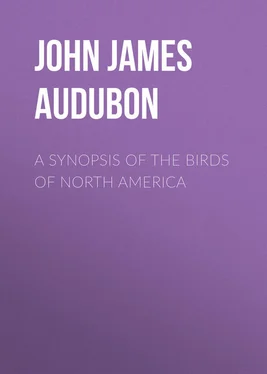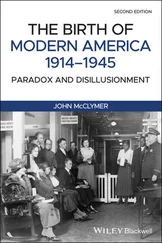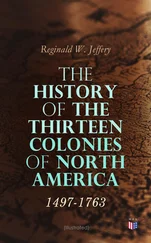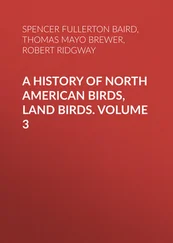John Audubon - A Synopsis of the Birds of North America
Здесь есть возможность читать онлайн «John Audubon - A Synopsis of the Birds of North America» — ознакомительный отрывок электронной книги совершенно бесплатно, а после прочтения отрывка купить полную версию. В некоторых случаях можно слушать аудио, скачать через торрент в формате fb2 и присутствует краткое содержание. Жанр: foreign_antique, foreign_prose, на английском языке. Описание произведения, (предисловие) а так же отзывы посетителей доступны на портале библиотеки ЛибКат.
- Название:A Synopsis of the Birds of North America
- Автор:
- Жанр:
- Год:неизвестен
- ISBN:нет данных
- Рейтинг книги:5 / 5. Голосов: 1
-
Избранное:Добавить в избранное
- Отзывы:
-
Ваша оценка:
- 100
- 1
- 2
- 3
- 4
- 5
A Synopsis of the Birds of North America: краткое содержание, описание и аннотация
Предлагаем к чтению аннотацию, описание, краткое содержание или предисловие (зависит от того, что написал сам автор книги «A Synopsis of the Birds of North America»). Если вы не нашли необходимую информацию о книге — напишите в комментариях, мы постараемся отыскать её.
A Synopsis of the Birds of North America — читать онлайн ознакомительный отрывок
Ниже представлен текст книги, разбитый по страницам. Система сохранения места последней прочитанной страницы, позволяет с удобством читать онлайн бесплатно книгу «A Synopsis of the Birds of North America», без необходимости каждый раз заново искать на чём Вы остановились. Поставьте закладку, и сможете в любой момент перейти на страницу, на которой закончили чтение.
Интервал:
Закладка:
Bill of moderate length, nearly straight, a little stouter than that of the last; wings short, with the third, fourth, and fifth quills almost equal, the fourth longest; tail rather short, much rounded. Upper parts dull reddish-brown, darker on the head, brighter on the tail-coverts, indistinctly barred with dusky; lower parts brownish-grey, faintly barred on the fore neck and breast, the sides, abdomen, and lower tail-coverts distinctly barred; feathers of the cheeks grey, tipped with brown; wings and tail undulatingly banded with blackish-brown. This species differs from the last in being considerably smaller, in having the bill shorter and stouter, the lower parts more tinged with brown; but the colouring of the two is extremely similar.
Male , 41/2, 51/2.
From Maryland to Nova Scotia, and across the continent to the Columbia River. Very abundant. Migratory.
House Wren, Sylvia domestica, Wils. Amer. Orn. v. i. p. 129.
Troglodytes ædon, Bonap. Syn. p. 92.
House Wren, Nutt. Man. v. i. p. 422.
Troglodytes ædon, House Wren, Swains. & Rich. F. Bor. Amer. v. ii. p. 316.
House Wren, Troglodytes ædon, Aud. Orn. Biog. v. i. p. 427; v. v. p. 470.
121. 6. Troglodytes hyemalis, Vieill. Winter-Wren
Plate CCCLX. Fig. 1. Male. Fig. 2. Female. Fig. 3. Young.
Bill of moderate length, nearly straight; wings shortish, with the fourth quill longest; tail short, much rounded. Upper parts reddish-brown, faintly barred with dusky, darker on the head, brighter on the tail-coverts, quills, and tail; lower parts pale reddish-brown, the sides and abdomen barred with brownish-black and greyish-white; fore neck and breast more faintly barred; lower wing-coverts and axillars greyish-white, barred with dusky, lower tail-coverts brownish-red, barred with dusky, and having the tip white; a whitish streak over the eye; cheeks brown, spotted with brownish-white; secondary coverts, and first small coverts, each with a white spot at the tip, forming two inconspicuous bands; wing-coverts and quills banded with blackish-brown and brownish-red; tail with twelve dusky bands.
This species is very nearly allied to Troglodytes Europæus .
Male , 37/8, 61½/12. Female , 35/8, 53/8.
Generally distributed in the middle and southern districts during winter. Breeds from Pennsylvania northwards to Hudson's Bay. Columbia River.
Winter-Wren, Sylvia Troglodytes, Wils. Amer. Orn. v. i. p. 139.
Troglodytes europæus, Bonap. Syn. p. 93.
Troglodytes hyemalis, Winter Wren, Swains. & Rich. F. Bor. Amer. v. ii. p. 318.
Winter-Wren, Troglodytes hyemalis, Nutt. Man. v. i. p. 427.
Winter-Wren, Troglodytes hyemalis, Aud. Orn. Biog. v. iv. p. 430.
122. 7. Troglodytes Parkmanii, Aud. Parkman's Wren
Bill rather long, slightly arched (much longer, stouter, and more curved than that of the last species); wings of moderate length, with the fourth quill longest; tail rather long, much rounded, (half an inch longer, and more rounded). Upper parts reddish-brown, faintly barred with dusky; lower parts dull brownish-white, sides barred with brownish-black and greyish-white, fore neck and breast with scarcely any markings, lower wing-coverts and axillars greyish-white, obscurely barred with dusky.
Length, 42/12, wing 21/4.
Columbia River. Not very rare.
Parkman's Wren, Troglodytes Parkmanii, Aud. Orn. Biog. v. v. p. 310.
123. 8. Troglodytes palustris, Wils. Marsh Wren
Plate C. Male and Female.
Bill rather long, slightly arched; wings short, with the fourth quill longest. Upper parts dark brown, the sides of the head deeper, the fore part of the back brownish-black, longitudinally and conspicuously streaked with white, the quills externally margined with lighter brown, the tail barred with dark brown; a white line over the eye, extending down the neck; the sides of the latter mottled with light brown and grey; the lower parts of a silvery greyish-white; abdominal feathers and lower tail-coverts tipped with brown. Female differs only in having the black of the back of a less deep tint, the white lines less conspicuous, and the lower parts of a duller white.
Male , 5, 61/4.
Breeds from Texas to Massachusetts, along all the shores of the Atlantic. Resident in Louisiana. Occurs accidentally far in the interior.
Marsh-Wren, Troglodytes palustris, Wils. Amer. Orn. v. iii. p. 58.
Troglodytes palustris, Bonap. Syn. p. 93.
Marsh-Wren, Troglodytes palustris, Nutt. Man. v. i. p. 439.
Troglodytes palustris, Marsh Wren, Swains. & Rich. F. Bor. Amer. v. ii. p. 319.
Marsh-Wren, Troglodytes palustris, Aud. Orn. Biog. v. i. p. 500; v. v. p. 467.
124. 9. Troglodytes brevirostris, Nutt. Short-billed Marsh-Wren
Plate CLXXV. Male and Female.
Bill comparatively very short, nearly straight; wings short, very convex, with the third, fourth, and fifth quills almost equal. Upper parts blackish-brown, each feather with a brownish-white line along the shaft, and the outer edge toward the end reddish-brown; quills dusky, the outer webs barred with pale yellowish-brown; upper tail-coverts and tail similarly barred; a pale yellowish streak over the eye; throat and central part of the breast greyish-white, the rest of the lower parts pale reddish-brown, the sides under the wings faintly barred with dusky.
Male , 43/8, 55/8.
Resident during winter from Texas to South Carolina. In spring proceeds as far eastward as Massachusetts, breeding in all the fresh-water marshes.
Short-billed Marsh-Wren, Troglodytes brevirostris, Nutt. Man. v. i. p. 436.
Nuttall's Short-billed Marsh-Wren, Troglodytes brevirostris, Aud. Orn. Biog. v. ii. p. 427; v. v. p. 469.
FAMILY X. PARINÆ. TITS
Bill very short or of moderate length, straight, strong, compressed, rather sharp; both mandibles with the dorsal line sloping and slightly convex, the sides convex, the edges sharp; notches obsolete. Nostrils basal, roundish, concealed by the feathers. Head rather large, roundish; neck short; body short, and rather full. Feet of moderate length, rather stout; tarsus rather short, compressed, with eight distinct scutella; toes large, the three anterior united as far as the second joint, the hind toe much stronger and flattened beneath; claws rather long, stout, arched, much compressed, acute. Plumage very soft, blended, and full. Feathers at the base of the bill directed forwards. Wings of moderate length, much rounded, with the first quill very small, the fourth and fifth longest. Tail rather long, slender, of twelve narrow rounded feathers. Tongue emarginate and papillate at the base, abrupt at the tip, with four bristles. Œsophagus narrow, without dilatation; proventriculus oblong; stomach a rather strong oblong gizzard, with the muscles distinct, the epithelium dense, thin, longitudinally rugous; intestine short, of moderate width; cœca very small; cloaca oblong. Trachea simple, with four pairs of inferior laryngeal muscles.
GENUS I. PARUS, Linn. TIT
Bill short, stout; upper mandible with the dorsal line slightly decurved toward the end, the edges overlapping, with a slight lobe or festoon near the base, destitute of notch, rather acute; lower mandible with the dorsal outline slightly convex, the edges direct, the tip rather acute. Nostrils roundish, covered by bristly feathers. Head rather large, roundish; neck short. Feet proportionally large; tarsus of moderate length; hind toe very large and strong, the two lateral nearly equal, the outer adherent at the base; claws large, much compressed, very acute. Wings of moderate length, convex. Tail long, or of moderate length, rounded or graduated, of twelve rather narrow feathers.
Читать дальшеИнтервал:
Закладка:
Похожие книги на «A Synopsis of the Birds of North America»
Представляем Вашему вниманию похожие книги на «A Synopsis of the Birds of North America» списком для выбора. Мы отобрали схожую по названию и смыслу литературу в надежде предоставить читателям больше вариантов отыскать новые, интересные, ещё непрочитанные произведения.
Обсуждение, отзывы о книге «A Synopsis of the Birds of North America» и просто собственные мнения читателей. Оставьте ваши комментарии, напишите, что Вы думаете о произведении, его смысле или главных героях. Укажите что конкретно понравилось, а что нет, и почему Вы так считаете.












